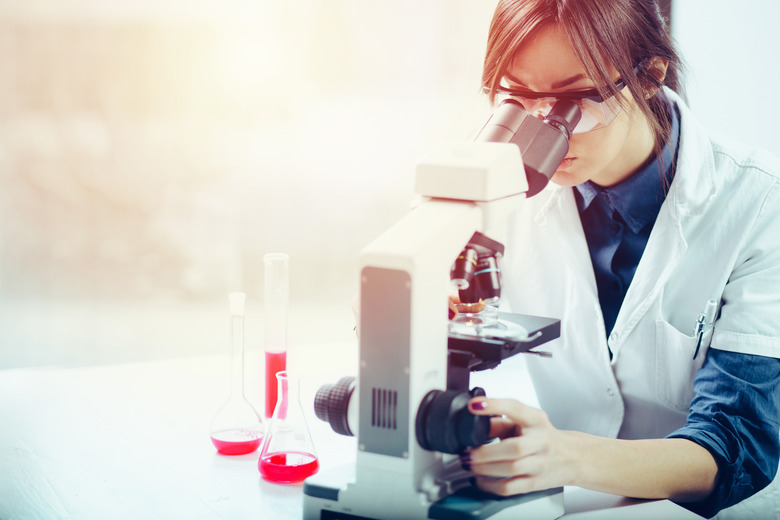5 Women Who Changed Our Understanding Of Science
The "ivory tower" of academia has had an uneasy relationship with women, and that's especially true in science, technology, engineering and mathematics (STEM) fields. Even today, women make up just 29 percent of the workforce in STEM fields, according to the National Girls Collaborative Project, and are especially underrepresented in engineering, physics and astronomy.
That doesn't mean, however, that women haven't contributed to scientific progress – in fact, women are behind some of the most significant discoveries in every STEM field, from biology to chemistry to computing. Read on to learn more about some of the female scientists who made major scientific breakthroughs – and how their work still helps us today.
Hilde Mangold
Hilde Mangold
German scientist Hilde Mangold was one of the pioneers of embryology, and her work with her advisor, Hans Spemann, uncovered a breakthrough in understanding amphibian development. Through grafting experiments – done before the development of sterile lab conditions that help experiments today – she discovered the Mangold-Spemann organizer, a subset of cells "fated" required for the development of the nervous system. These discoveries helped later developmental biologists better understand mammalian development – including human development.
Though Spemann eventually won a Nobel Prize for advising Mangold's work, Mangold died early in life – before she could see the impact of her work on the scientific community.
Rosalind Franklin
Rosalind Franklin
Francis Crick, James Watson and Maurice Wilkins may have gotten the credit – the the Nobel Prize – for discovering the structure of DNA, but they probably wouldn't have make their discoveries without the work of Rosalind Franklin.
Franklin's work involved taking X-ray photographs of DNA molecules, a technique called X-ray diffraction. It was these X-rays that helped Watson visualize the double helix structure of DNA – and go on to discover its chemical structure.
Lise Meitner
Lise Meitner
An Austrian and Swedish nuclear physicist, Lise Meitner discovered nuclear fission, the process through which a larger atom splits into two (or more) smaller particles. The real-world applications of fission are still important today – fission reactors are the most common type of nuclear reactor, making fission essential for energy production, and (less pleasantly) fission is also the chemistry behind atomic bombs. Meitner's colleague, Otto Hahn, went on to win a Nobel Prize for their work.
However, Meitner continued to blaze trails in science. She was the first woman in Germany to achieve a full-time position as a professor, and went on to continue her work at the University College of Stockholm in Sweden.
Ada Lovelace
Ada Lovelace
Whether you're reading this on your phone, a tablet or a computer, you can thank Ada Lovelace for helping develop the earliest computer technology. As a mathematician in England in the early and mid 1800s, Lovelace developed her own coding language and created what is often called the first computer program, long before the first electronic computers were invented.
Lovelace also made predictions about technology that would later prove true – especially the value of computers for mathematics and calculations, as well as developing. Today, International Lovelace Day helps raise awareness of and celebrate women in STEM fields.
Jocelyn Bell
Jocelyn Bell
Rounding out our list of underrated female researchers is Jocelyn Bell, an astrophysicist based in Britain. Bell was a graduate student when she discovered the first pulsar, a type of neutron star that emits strong electromagnetic radiation. Pulsars emit such strong radiation that Bell called the radio waves she observed Little Green Men, or LGMs, jokingly postulating that they might come from extraterrestrial life. Thanks to Bell's work, her advisor Tony Hewish won the Nobel Prize in Physics in 1974.
Learning about pulsars continues to expand our understanding of the universe today. Pulsars help astrophysicists identify gravitational waves – which can signal the presence of star systems.
Cite This Article
MLA
Tremblay, Sylvie. "5 Women Who Changed Our Understanding Of Science" sciencing.com, https://www.sciencing.com/5-female-researchers-who-changed-our-understanding-of-science-13400297/. 27 June 2017.
APA
Tremblay, Sylvie. (2017, June 27). 5 Women Who Changed Our Understanding Of Science. sciencing.com. Retrieved from https://www.sciencing.com/5-female-researchers-who-changed-our-understanding-of-science-13400297/
Chicago
Tremblay, Sylvie. 5 Women Who Changed Our Understanding Of Science last modified August 30, 2022. https://www.sciencing.com/5-female-researchers-who-changed-our-understanding-of-science-13400297/
